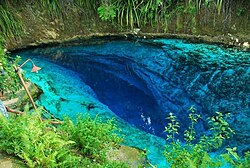Surigao del Sur | |
|---|---|
(from top: left to right) Tinuy-an Falls in Bislig, White beach in Cagwait, surfer in beach of Lanuza, Hinatuan River, Britania Islands, and San Nicolas de Tolentino Cathedral | |
| Nickname: Shangri-La by the Pacific [1] | |
 Location in the Philippines | |
 Interactive map of Surigao del Sur | |
| Coordinates: 8°40′N126°00′E / 8.67°N 126°E | |
| Country | Philippines |
| Region | Caraga |
| Founded | June 19, 1960 |
| Capital | Tandag |
| Largest city | Bislig |
| Government | |
| • Type | Sangguniang Panlalawigan |
| • Governor | Johnny T. Pimentel (NUP) |
| • Vice Governor | Manuel O. Alameda (PFP) |
| • Legislature | Surigao del Sur Provincial Board |
| Area | |
• Total | 4,932.70 km2 (1,904.53 sq mi) |
| • Rank | 21st out of 82 |
| Highest elevation (Mount Diuata) | 611 m (2,005 ft) |
| Population (2024 census) [3] | |
• Total | 648,858 |
| • Rank | 47th out of 82 |
| • Density | 131.542/km2 (340.693/sq mi) |
| • Rank | 66th out of 82 |
| Demonym | South Surigaonon |
| Divisions | |
| • Independent cities | 0 |
| • Component cities | |
| • Municipalities | |
| • Barangays | 309 |
| • Districts | Legislative districts of Surigao del Sur |
| Time zone | UTC+8 (PHT) |
| IDD : area code | +63 (0)86 |
| ISO 3166 code | PH-SUR |
| Spoken languages | |
| Income classification | 1st class |
| Website | www |
Surigao del Sur (Surigaonon: Probinsya nan Surigao del Sur; Cebuano : Habagatang Surigao; Tagalog : Timog Surigao), officially the Province of Surigao del Sur, is a province in the Philippines located in the Caraga region in Mindanao. Its capital is Tandag City while Bislig is the most populous city in the province. Surigao del Sur is situated at the eastern coast of Mindanao and faces the Philippine Sea to the east.














